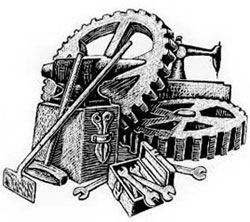Women Battling Jim Crow and Jane Crow
With the recent passing of Dorothy Height, the well-known and long-time leader of the National Council of Negro Women, we’ve had a chance to hear again about the lack of female leaders in the planning of the 1963 March on Washington.  Height, one of a few women to sit on the platform (along with Corretta Scott King and Juanita Abernathy), was also the only woman included in the March’s planning meetings.  In a 2003 interview, Height tried to explain why she and other women accepted this limited role at the time:
…We accepted that because we saw that the whole objective of freedom and equality and jobs and justice was great enough for us to say ‘we’ll deal with this at another moment’ and we did. Â I don’t think today it could be a march and not have a woman speaker.
In fact, at the time of the march and especially in the months that followed, women activists were incensed about their exclusion from planning and leadership in the black freedom struggle.  Pauli Murray, a lawyer who had been involved in the March on Washington Movement since the A. Phillip Randolph days back in 1940s Chicago, called out male Movement leaders for acting just like any other “entrenched power group”:
Recent disquieting events have made imperative an assessment of the role of the Negro woman in the quest for equality. Â The civil rights revolt, like may social upheavals, has released powerful pent-up emotions, cross currents, rivalries and hostilities… Â There is much jockeying for position as ambitious men push and elbow that way to leadership roles.
What emerges most clearly from events of the past several months is the tendency to assign women to a secondary, ornamental or “honoree” role instead of the partnership role in the civil rights movement which they have earned by their courage, intelligence and dedication.  It was bitterly humiliating for Negro women on  August 28 to see themselves accorded little more than token recognition for the historic March on Washington.  Not a single woman was invited to make one of the major speeches or to be part of the delegation of leaders who went to the White House.  This omission was deliberate.  Representations for recognition of women were made to the policy-making body sufficiently in advance of the August 28 arrangements to have permitted the necessary adjustments to the program.  What the Negro women leaders were told is revealing: that no representation was given to them because they would not be able to agree on a delegate.  How familiar was this excuse!  It is a typical response from an entrenched power group…*
In this same widely-circulated speech, Murray outlined the dual burdens of Jim Crow and “Jane Crow” on black women. Â Murray would later be instrumental in ensuring that gender was added to the clause that banned employment discrimination based on race, color, religion or national origin in the landmark Civil Rights Act of 1964. Â She noted that the quest for women’s and African Americans’ rights had historically run parallel and were in fact part of the same larger struggle for human rights.

Marchers at the 1968 Poor People's March, Washington, D.C. (Library of Congress)
We used both of these documents, and many others, in a Teaching American History seminar with teachers this week.  Throughout the day we looked at the black freedom struggle through the lens of women and the local struggles they engaged in.  We wanted to examine not only the actions of women activists–organizing the boycott in Montgomery, picketing segregated schools in New York and Milwaukee, driving voters to the poll in Mississippi, sitting-in in mayors’ offices in Seattle–but also the ways that women expanded the very notions of what full equality and “rights” entailed.  We see this in the Cambridge (Maryland) Movement in 1963, when Gloria Richardson pushed local leaders to see that voting rights were not enough when black students attended inadequate schools and black workers could not get high-paying jobs.  Women were at the center of other protests about how to make a more economically just society, with their advocacy of welfare reform and participation in “poor people’s marches.”  As Johnnie Tillmon noted in her landmark 1972 essay “Welfare is a Women’s Issue”:
The truth is a job doesn’t necessarily mean an adequate income. Â There are some ten million jobs that now pay less than the minimum wage, and if you’re a woman, you’ve got the best chance of getting one… Â Maybe [with our Guaranteed Adequate Income welfare reform plan] we poor welfare women will really liberate women in this country…”
Murray, Richardson and Tillmon are all examples of how, at key moments of transition in the philosophy and tactics of the black freedom struggle, Â women shaped not only the on-the-ground strategies of the movement, but also its ideology.
*Pauli Murray, “The Negro Woman in the Quest for Equality,” speech, 14 November 1963, reprinted from The Acorn (June 1964), Schlesinger Library at Radcliffe College, available from Women and Social Movements in the United States, 1600-2000.
Last 5 posts by Leah Nahmias
- Teaching "What This Cruel War Was Over" - March 28th, 2011
- State of Siege and Public Memory at Ole Miss - March 25th, 2011


